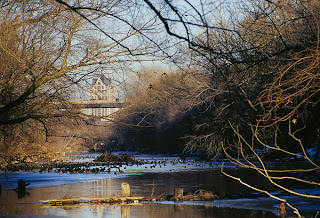What were we thinking?!! Well, we were thinking the way we think: that we had a day to be together; it was a nice sunny day; we like to hike; and we are near the Kettle Moraine State Forest
We clearly were not thinking about hunting, or hunters, or that this was the first day of hunting season! But, as soon as we left West Bend Wisconsin
We didn’t witness any actual hunting, mind you. At infrequent, irregular intervals we heard shots off in the distance, but never saw any action. What we saw were clusters of vehicles wherever there was a place to pull off the park road. We glimpsed blaze orange glinting through the trees and saw orange action figures wandering in full sight around the edges of fields. Some merely sat, like this one (above) we drove past on our way to one of the few designated “no hunting” zones in the park. An hour or so later, after our hike, he and two others standing nearby didn’t seem to have moved. As I popped out of my car to take the photo, I wondered uneasily what would happen if a deer ran between me and him. I quickly got back in and drove off.
In places the hunters were so thick they put me in mind of the “backwoods humorist” Norman Pettingill, who made innumerable drawings of Northwoods culture, many of which depict the foibles of hunters. In his crazy cartoons hunters fill every available space between trees, blast away indiscriminately, drink incessantly, etc. Coincidentally (?), we saw a display of Pettingill’s work, done over five decades of the Twentieth Century, at the John Michael Kohler Art Center in Sheboygan
We stopped at the Ice Age Trail Visitors Center to inquire about safe places to hike and were rewarded by a friendly ranger who gave us the map – and lent us each an orange vest. Thus fortified, we made our way to
The interpretive signage in this section identified it as a cedar swamp. The cedars have shallow root systems and therefore fall over easily. In some places there seemed to be more fallen ones than were left standing. The monochromatic late autumnal colors conspired with the apparent devastation to make the landscape seem apocalyptic. To my eye, all of it was beautiful, none of it picturesque.
We saw only three people the whole time. Two looked like puffy blaze orange snowmen, sitting awkwardly at a picnic table in the campground. The third was this lone kayaker making his way up the
A great fusillade of shots somewhere beyond the tree line reminded us of the orange army that has invaded the park. My thoughts turn toward their target. For the record, I have no quarrel with those who kill deer – as long as they do it responsibly. (In the tiny, tenth-of-an-acre urban wilderness that is my front yard, the deer are nothing but plant-killing pests. I rarely see them; only their night time rubbings and chewings.) I, however, find the quiet sounds of nature itself more agreeable than the sound of guns. The sigh of wind in the trees and the honking of geese high overhead fill me with peace.

































